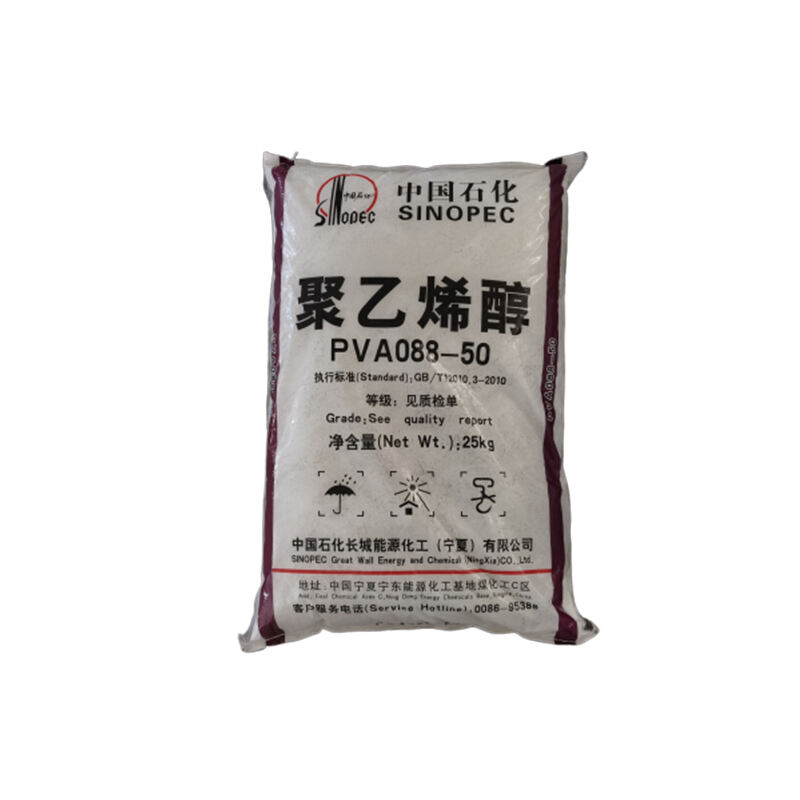Förstå de kemiska egenskaperna hos polyvinylalkohol
Inledning till polyvinylalkohol
Definition och kemisk struktur
Polyvinylalkohol (PVA) är en syntetisk polymer som är känd för sin mångsidighet och miljövänlighet. Det härrör från hydrolysen av polyvinylacetat, där acetatgrupperna (-OCOCH3) i polyvinylacetat ersätts med hydroxylgrupper (-OH). Strukturellt representeras PVA av den upprepande enheten [CH2-CHOH]n där 'n' anger antalet monomerenheter. Detta ger PVA unika egenskaper som gör det värdefullt för olika tillämpningar.
Syntes av polyvinylalkohol
Syntesen av PVA innebär vanligtvis två primära processer: partiell hydrolys och fullständig hydrolys av polyvinylacetat. Beroende på hydrolysens omfattning kan PVA klassificeras i olika grad av polymerisering. Dessa grader påverkar dess fysikaliska och kemiska egenskaper, vilket påverkar faktorer som löslighet, viskositet och filmbildande förmåga.
Översikt över egenskaper
PVAs särdrag är bland annat dess låga toxicitet, utmärkta filmbildande förmåga och vattenlöslighet, vilket öppnar möjligheter till användning inom områden som biomedicinsk teknik, textiltillverkning och livsmedelsförpackningar.
Kemiska egenskaper hos polyvinylalkohol
Molekylvikt och grad av polymerisering
PVA:s molekylvikt kan variera kraftigt beroende på tillverkningsprocessen, vanligtvis mellan 20 000 och 400 000. Polymerisationsgraden, som beskriver antalet monomerenheter i PVA-kedjan, spelar en avgörande roll för dess viskositet och mekaniska hållfasthet. Som framhållits i litteraturen leder högre grad av polymerisering alltid till en mer viskös vattenlösning, vilket ökar styrkan men minskar lösligheten.
Solubilitetsegenskaper
PVA har en utmärkt löslighet i vatten, främst på grund av att det innehåller hydroxylgrupper. Dessa grupper underlättar vätebindning med vattenmolekyler, vilket gör det lätt att upplösa. Intressant är att lösligheten hos PVA kan påverkas av graden av hydrolys; helt hydrolyserad PVA är mindre löslig i kallt vatten men löser sig lätt i varmt vatten, vilket visar på dess temperaturberoende löslighetsegenskaper. PVA är inte lösligt i organiska lösningsmedel som bensin och toluol.
Termiska egenskaper
PVA:s termiska stabilitet är av yttersta vikt för dess olika tillämpningar. PVA har en smältpunkt på cirka 230 °C och börjar brytas ner vid temperaturer över 200 °C. Dessutom varierar PVAs glasövergångstemperatur mellan 75 °C och 85 °C, vilket gör den lämplig för applikationer som kräver värmebeständighet.
Fysiska egenskaper och prestanda
Filmformningskapacitet
En av de mest anmärkningsvärda egenskaperna hos PVA är dess förmåga att bilda starka, genomskinliga filmer. Dessa filmer är flexibla och motståndskraftiga mot oljor och fetter, vilket gör PVA idealiskt för användning i förpackningar och beläggningar. När PVA gjuts i tunna lager skapar det film som effektivt kan motstå kemisk penetration och ger en barriär som är både funktionell och estetisk.
Mekaniska egenskaper
PVA har goda mekaniska egenskaper, bland annat dragstyrka och flexibilitet. Dessa egenskaper kan förbättras genom blandning av PVA med andra polymerer eller genom korslänkning. Denna mångsidighet gör att PVA kan skräddarsys för specifika applikationsbehov, allt från textiltillämpningar till läkemedelsleveranssystem inom biomedicinskt område.
Biologisk nedbrytbarhet och miljöpåverkan
PVA är känd för sin biologiska nedbrytbarhet under vissa förhållanden, vilket gör det till ett hållbart alternativ till många konventionella plaster. Hydrolysen av PVA leder till bildandet av miljövänliga biprodukter som vatten och koldioxid, vilket understryker dess potentiella roll för att främja en cirkulär ekonomi.
Användning av polyvinylalkohol
Industriell användning
I industriella miljöer används PVA i stor utsträckning vid tillverkning av lim, filmer och beläggningar. Det kan också användas som ett vävnadsbehandlingsmedel och som dispergeringsmedel i olika kemiska formler. PVA:s filmbildningseffekt understryker dess betydelse i industrier där skyddsbeläggningar är nödvändiga.
Biomedicinska tillämpningar
PVA är biokompatibel och giftfri och lämpar sig därför för olika biomedicinska tillämpningar. Dess användning för att skapa hydrogeler har underlättat framsteg inom läkemedelsleveranssystem, sårförband och till och med konstgjord brosk. Hydrogelformerna av PVA är anpassningsbara och kan konstrueras för riktade terapeutiska funktioner.
Innovationer och framtida riktningar
När industrin söker efter mer hållbara material är PVA på väg att bli en innovationskraft. Forskare fortsätter att undersöka nya formuleringar och blandningar av PVA med naturliga polymerer för att förbättra dess egenskaper och utöka dess tillämpningar. Nya tekniker inom 3D-utskrift och biomaterial ger PVA spännande möjligheter att spela en central roll i utvecklingen av framtida material.
Slutsats
Att förstå de kemiska egenskaperna hos Polyvinylalkohol öppnar dörrar för att utnyttja dess fulla potential i olika tillämpningar. Från dess utmärkta filmformande förmåga till dess biokompatibilitet, gör PVA:s mångsidighet det till en ovärderlig aktör inom både industriella och biomedicinska områden. Med ett växande fokus på hållbarhet kommer utvecklingen kring PVA sannolikt att bidra avsevärt till framsteg inom materialvetenskapen under de kommande åren.
Genom att omfamna innovationer och fortsätta forskningen kan polyvinylalkohol bana väg för mer miljövänliga lösningar som uppfyller kraven i modern teknik och miljö.

